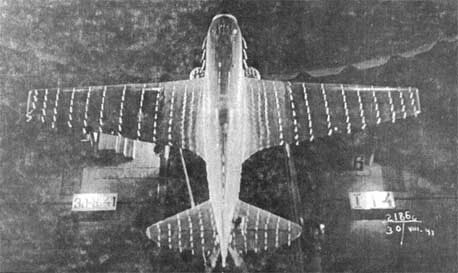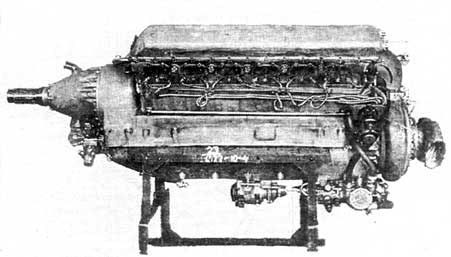
The photo shows a mockup with trapezoidal wings, ski landing gear and stripes on a T-101 wind tunnel.
|
|
|
|
Trapezoidal wing MiG-3
 |
During August 1941, TsAGI proposed the installation of trapezoidal
wingtips on the MiG-3, that, according to wind tunnel tests, should decrease
the landing speed of about 5 km/h; this modify was rejected, because such
a small improvement couldn't justify trouble in a full working assembling
line.
The photo shows a mockup with trapezoidal wings, ski landing gear and stripes on a T-101 wind tunnel. |
MiG-7 (izdelye 72)
 |
During April 1941, the engine AM-37 was approved for series production.
A MiG-3 equipped with an AM-37 engine was built and named MiG-7. Test pilot N.P.Baulin and chief engineer V.N.Sorokin were assigned to its factory tests. The first flights revealed a poor longitudinal stability, that would require wide reprojecting of the aircraft. The AM-37 engine was removed from the MiG-7 to be installed on the DIS-200 (MiG-5) heavy fighter prototype. The beginning of the war led to abandoning the project, because of the priority of AM-38F production for Il-2s. |
MiG-3 AM-38
One weak point of the MiG-3 was its poor performance at low altitudes,
where the most of air combat took place.
To remedy to this, the aircraft n.3595 was equipped with an AM-38F
engine with a takeoff power of 1600 hp and a AV-5L-110A propeller.
The aircraft made its maiden flight on July 31, 1941, and conducted
tests for the following 12 days. Test pilots Y.K. Stankevich and chief
engineer K.N. Mkrtychan were assigned to the test program.
The greater power improved by much the aircraft's performances, particularly
maximum speed, up to the altitude of 4,000 m.
In the first configuration the aircraft reached 582 km/h at 3400 m altitude,
while in the second configuration it reached 592 km/h.
While the AM-38 F engine could easily replace the AM-35A without structural
modifies, the cooling system revealed to be unsufficient for this more
powerful engine, and this limited the operability of the aircraft to temperatures
not higher than 16°C on the ground.
After the test in NII, the aircraft returned in Zavod 1 for modifies,
but after this the aircraft gave problems with the supercharger, and during
a flight the aircraft suffered deformation of fuel tanks. After 22 flights,
on September 22 the aircraft returned to the factory for repairs.
On October 4 the aircraft flew again on the airstripe of Zavod 1, but
the following day the aircraft crashed killing the test pilot N.P.Baulin.
An investigation showed that the cause of this was a combat with an
enemy aircraft.
Due to the shortage of AM-35A, some units conducted their own experiment
on the use of AM-38. Two aircrafts of 402 IAP were modified in such way
during November 1941, and were tested by the regimental commander Major
K.A.Grudzev, and squadron commander captain B.G. Boroday. The first of
them shot down two enemy bombers while testing the modified aircraft n.
4184.
Note: this page is widely based on the article of Arsenyev at http://www.23ag.sp.mk.ua/html/mig_3.html
|
|